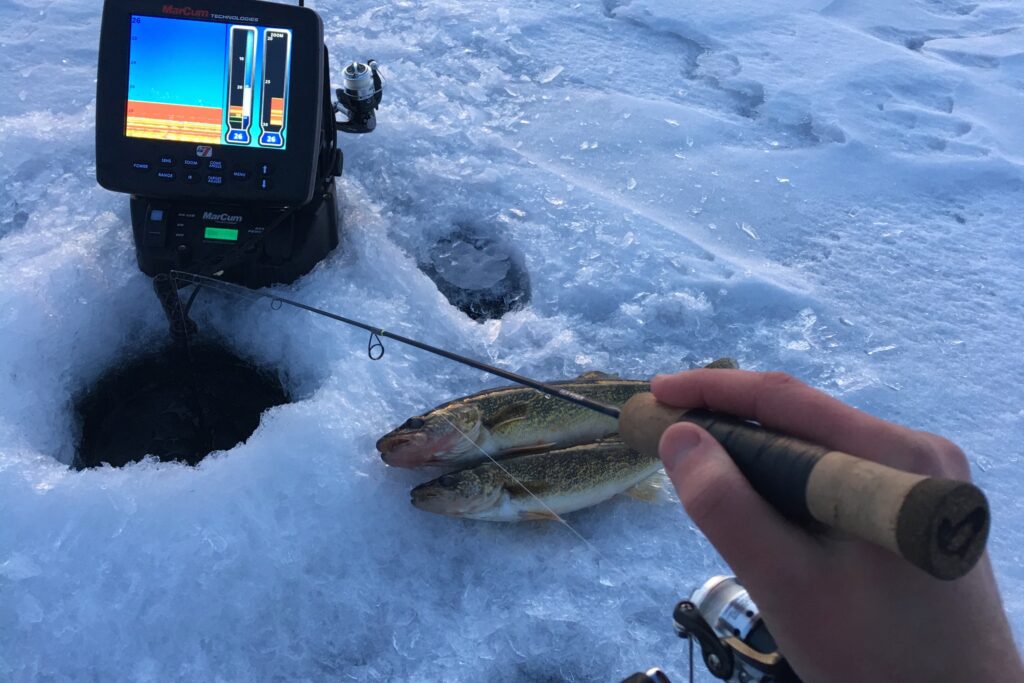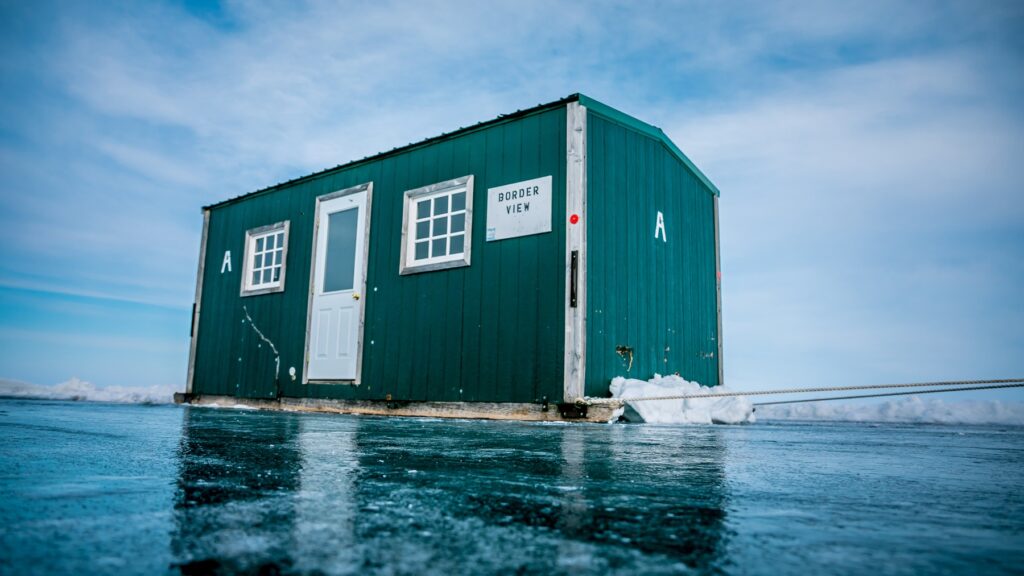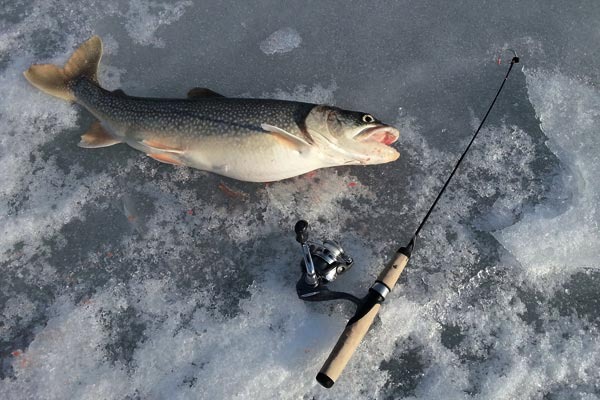As the biting winds of winter sweep across Canada’s northern landscapes, ushering in frosty morning airs and coating trees, rocks, and shores in a blanket of pure white snow, my mind often drifts to thoughts of ice fishing. Having grown up spending winters upon the frozen waters that dot Ontario’s vast wilderness, ice fishing holds a special place in my heart – it’s more than just a pastime; it’s deeply ingrained in who I am. There’s something profoundly soothing about quietly sitting upon the ice, surrounded by nature’s stillness, with only the rhythmic lure of hook and line to break the silence.

This winter, I’ve set my sights on exploring one of North America’s most legendary ice fishing destinations – Lake of the Woods. Straddling the border where Ontario meets Manitoba and Minnesota, this sprawling lake is renowned amongst anglers for its abundance of trophy-sized fish. Spread across an immense 14,583 islands and over 65,000 kilometers of shoreline, its quiet bays and inlets hide all manner of prizes just waiting to be hooked. As someone who’s made a career out exploring the world’s top fishing locales, I can’t wait to experience the hard water magic of Lake of the Woods for myself.
In this blog post, I aim to share some of the key aspects of ice fishing on Lake of the Woods to help pique your interest and provide valuable tips for planning your own winter excursion. From preferred techniques and prime species to the best times to visit and necessary gear, read on for an insider’s guide to one of North America’s true frozen fishing meccas.
What are the ice fishing techniques on Lake of the Woods?
When it comes to strategies for catching fish beneath the ice, anglers on Lake of the Woods have their methods well refined. Here are a few of the top techniques employed:
Jigging

Arguably, the most popular approach, jigging, involves vertically raising and lowering lures like spoons or jigging raps fitted with live or artificial baits. For walleye and sauger, this proven technique sees anglers impart action to attract strikes.
Tip-Upping
Consisting of lines suspended in holes with flags affixed, tip-ups allow fishermen to freely move between sets while flagging alerts signal bites. Dead baits like ciscoes work well for monster pike and muskies lurking the shallows.
Darkhouse Spearing
A true test of stealth and patience, this traditional method has anglers crouch in darkened ice shacks with a spear, waiting perfectly still for an opportune strike. Pike are a common target for stalwart spearmen brave enough to try.
Still-Fishing
A more relaxed approach letting baited lines simply sit motionless upon the bottom. Best used in deeper spots and when other methods prove unfruitful, it can unexpectedly pay off.
With such varied options, there’s a technique to suit every angler’s style when plying the frozen waters of Lake of the Woods.
How is the ice fishing in Lake of the Woods?
Lake of the Woods truly lives up to its reputation as a world-class fishery. Its abundance and diversity of species is unmatched, offering anglers the chance to fill their creels with a variety throughout the year:

Walleye
The prized trophy of Lake of the Woods, “Walleys” reach immense sizes here with many over 25 inches caught annually. Using jigs tipped with minnows or leeches is a proven tactic.
Sauger
The slightly smaller cousin of walleye, these feisty fishers also school in shoals around structure. Look for them near reefs and breaklines jigging.
Northern Pike
Massive “Jackpike” over 40 inches lurk the shallows, making pike an exciting quarry. Dead baits suspended beneath tip-ups work well for lunkers.
Crappie
Beautiful panfish with a delightful flavor, slabs over 1lb aren’t unheard of. Try jigging marabou jigs near fallen trees.
Lake Trout

Deepwater “Lakers” averaging 5-15lbs provide acrobatic battles on light gear in winter. Tube jigs or sonars entice strikes.
Whitefish
Abundant and delicious, whitefish are often overlooked by open-water anglers but great onLake of the Woods’ frozen flats.With such a diversity of species on offer, every fishing experience on Lake of the Woods promises to be a unique adventure.
What kind of fishing is in Lake of the Woods?
While open-water fishing remains popular on Lake of the Woods from spring through fall, it truly comes into its own as an ice fishing destination in the colder months. Some of the top winter fishing opportunities include:
Ice Fishing
From November through April, anglers flock to the frozen expanses in search of myriad species. Jigging, tip-ups, and spearing are common methods plying the ice.
Hard Water Tournaments
Numerous competitive ice fishing derbies and contests run throughout the season, with cash and prizes on the line for biggest catches by weight.
Winter Guided Trips
Local outfitters offer half and full-day excursions via snowmobile or UTV, equipping clients with tackle, shacks, and insider knowledge.
Fly-In Fishing Lodges
Remote border country and island resorts provide trips combining winter activities with exceptional pure ice angling in remote bays.
Spearfishing
For the truly intrepid, “hard water hunting” Northern Pike beneath the ice adds an extra thrill of the unknown to winter exploits.So whether you prefer the camaraderie of tournaments, guided comforts, or true wilderness escapades, Lake of the Woods guarantees unique icy adventures.
When can you ice fish on Lake of the Woods?
The typical ice fishing season on Lake of the Woods runs from about mid-December through late March or early April, weather dependent. Here’s a closer look at season timing:

- Mid/Late December: As long as ice depth reaches minimum safety standards of 4-6 inches, anglers may start venturing onto frozen flats and bays. Walleye and perch are initial top targets.
- January-February: Peak of prime season with ice typically 1-2ft thick. All species readily biting, cold temperatures bring out hearty ice soldiers. Cold fronts may see fish rising.
- March: As ice begins deteriorating toward season’s end, focus shifts to shallow weedlines and structure before breakup. Northerns and lakers still active.
- Mid-April: With rapid daytime melts and thinning sheets, the hard water is slowly relinquished back to open waters. Lingering ice may still support fishing for hearty souls.
Keeping an eye on local reports and monitoring ice safety is paramount. With proper precautions, anglers can soak up the solitude and solids fishing Lake of the Woods offers throughout its lengthy winter ice fishing spell.
Is Lake of the Woods good for ice fishing?
In a word – yes! Lake of the Woods is absolutely renowned amongst ice anglers as one of the top frozen water fisheries in North America. Here’s why it earns such acclaim:

- Abundance of Trophy Fish: With its robust habitat, many Lake of the Woods’ fish push well over average sizes, from multi-pound crappie to monstrous 40″+ pike.
- Diverse Species: Anglers can target a hugely varying mix including walleye, sauger, trout, perch, whitefish, and more, keeping things interesting.
- Vast Waters: At over 65,000km of shoreline across its 14,500+ islands, fishing grounds are endless with structure holding fish all winter long.
- Established Culture: Ice fishing is deeply ingrained in the local culture and economy, with many resorts, lodges, and outfitters specializing in winter activities.
- Extended Season: Its remote northern location allows ice season to extend from December into April, offering ample fishing opportunities.
Few places on earth can match Lake of the Woods when it comes to reliably productive ice fisheries blessed with epic proportions. Its hallowed waters are truly made for memorable cold-water angling adventures.
What is used for ice fishing?
There are a few key pieces of equipment essential for any successful ice fishing expedition:
Ice Auger
Whether manual or powered, an auger is used to drill holes in the ice. Battery-powered models have gained popularity for efficiency.
Tip-Ups
These spring-loaded flags attached to fishing lines allow anglers to monitor multiple rods at once from a distance.
Ice Fishing Rods
Lightweight, shorter rods between 2-4 feet in length are ideal for precision presentations through small ice holes.
Ice Fishing Reels
Often incorporated directly into rod handles for compact portability, reels must be durable, smooth, and resistant to freezing environments.
Lures & Baits
From live bait like minnows and waxworms to artificial jigs, spoons, and flies, a variety of enticements cover all species’ preferences.
Ice Shelters
Providing shelter from wind and snow, quality portable shelters like shanties are a necessity for comfort on long winter excursions.
Layered Warm Clothing
It would be folly to underestimate cold northern conditions – layers of thermal tops and bottoms, hats, gloves, and appropriate outerwear are mandatory.Proper ice fishing equipment makes the difference between a miserable experience and enjoying success on even the bitterest of days. Quality gear pays dividends.
What is best for ice fishing?
While personal preferences vary, here are a few items any serious ice angler would be hard-pressed to fish without:
Insulated Ice Shelter
A roomy shelter to stay shielded from biting winds and falling snow allows enduring intense cold comfortably for extended periods.
Quality Ice Auger
For the crucial work of drilling access holes efficiently, a top-performing auger is critical – gas-powered models excel in speed and power.
High-Visibility Line
Being able to detect the most subtle of bites requires highly visible fluorocarbon or monofilament in transparent ice conditions.
Thermal Base Layer
Merino wool or polypropylene tops and bottoms wick moisture and retain insulation even when saturated, prolonging survivable time on the ice.
Layered Mitts & Hat
Pairing a thin liner glove inside a heavier insulated mitt, along with a hat covering ears, are essential for preventing critical heat loss.
Tungsten Jigging Spoons
Among the most universally enticing lures across all species, having an assortment of sizes and colors covers all eventualities.With the right essential equipment dialed in, even the harshest winter conditions hold no power to dampen the appeal of ice fishing’s solitude and rewards.
What part of a Lake is best for ice fishing?
When exploring an unfamiliar frozen lake like Lake of the Woods, focusing fishing efforts in the right zones is key to locating concentrations of fish. Some prime areas to target include:
- Points & Shoals: Underwater trails leading to deeper water are ambush sites.
- Rock Reefs & Hard Bottom: Structure attracts forage and fish holding over winter.
- Weedlines: Transition areas between vegetation and open water are productive.
- Nearshore Deep Holes: Basins in less than 15′ of water hold fish cruising shallower flats.
- Major Creek & River Mouths: Inflows influence oxygen and forage, drawing predators.
- Submerged Islands: Shoreline structure and breaks create crucial habitat.
- Narrow Sections: Funnel more fish through confined areas to intercept.
With Garmin units or local knowledge, identifying likely features on sonar assists narrowing the vast lake into discrete honey holes. Subtle variations in bottom composition can make or break an outing.
FAQs
What is the best time of day for ice fishing?
A: Early mornings and evenings generally see best bite activity as fish feed more actively at dawn and dusk. Around migrations, front movements also enhance action.
How thick should ice be to safely support an angler?
A: As a general rule, 4-5 inches of clear, solid blue ice can hold an individual, 6-8 inches an ATV/UTV, 10-12 inches a medium truck, and over 12 inches is needed for RV travel. Always check thickness away from shore.
What should I use for live bait on Lake of the Woods?
A: Fathead minnows and suckers procured locally work exceedingly well as forage matches local species. Waxworms and spikes are also effective if minnows aren’t available. Never transfer any live bait between bodies of water.
How do I know which lures/baits to use?
A: Ask local tackle shops and bait distributors for intel on what’s currently producing best. Also try mimicking available forage – minnows for pike and walleye, smaller baits for panfish. Having variety is key to experiment success.
What safety gear should always be brought on ice fishing?
A: Essentials include a ice awl or grippers for self rescue, line or flotation device, extra candles or hand warmers within reach, extra layers and insulated outerwear, fully charged phone in waterproof case, and informing others of plans and expected return time. Being prepared prevents problems.
I hope this comprehensive guide has provided all the essential intel needed for planning a truly memorable ice fishing excursion to Lake of the Woods this upcoming season. Its hallowed waters really do offer some of the finest frozen fishing opportunities available anywhere. Tight lines and fair winds – I’ll see you out on the hard water!
Also read: TOP 9 BEST FISHING LAKES IN TEXAS
